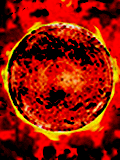Organic Lesson 60"Aromatic Compounds"
Science and Technology Standards:
PA Standard 3.4.12A: Apply concepts about the structure and properties of matter.
Anchor Assessment S11.A.1.1: Analyze and explain the nature of science in the search for understanding the natural world and its connection to technological systems.
Anchor Assessment S11.A.1.2: Identify and analyze the scientific or technological challenges of societal issues; propose possible solutions and discuss implications.
Anchor Assessment S11.A.1.3: Describe and interpret patterns of change in natural and human-made systems.
Anchor Assessment S11.A.2.1: Apply knowledge of scientific investigation or technological design to develop or critique aspects of the experimental or design process.
Anchor Assessment S11.A.2.2: Evaluate appropriate technologies for a specific purpose, or describe the information the instrument can provide.
Anchor Assessment S11.A.3.2: Compare observations of the real.
Anchor Assessment S11.A.3.3: Compare and Analyze repeated processes or recuring elements in patterns.
Anchor Assessment S11.B.1.1: Explain structure and function at multiple levels of organization.
Anchor Assessment S11.C.1.1: Explain the relationship between the structure an properties of matter.
Purpose:
1. I will name arenes.
2. I will draw the orbital structure of arenes.
3. I will draw the resonance forms of benzene.
3. I will identify the bond lengths of benzene.
Homework Due:
1. Complete Notes on Introduction - Section 5.3
Handouts/Supplies:
1. No handouts
I. Introduction
Opening Assignment:
Warm-Up: Draw an arene.
Review warm-up
State the purpose
II. The Lesson:
Activity #1: Review chapter 3 "Aromatic Compounds" Introduction
Activity #2: Discuss the following: 1. Aromatic definitions: Fragrant, Benzene like empty
2. benzaldehyde (cherries, peaches, almonds), toluene (tolu balsam), and benzene (coal distillate) Activity #3: Review section 5.1 "Structure of Benzene: The Kekule Proposal"
Activity #4: Discuss the following: 1. Benzene: Unreactive, substitution not addition
2. ortho- (o-), meta (m-), and para- (p-) Activity #5: Review section 5.4 "The Friedel-Crafts Alkylation and Acylation Reactions"
Activity #6: Discuss the following: 1. Alkylation Reaction (mechanism)
2. Alkylation Reaction (-NO2, -CN, -SO3H, -COR)
2. Acylation Reaction
2. Resonance forms of benzene (1.5 bond lengths, orbital structures) Activity #7: Review section 5.5 "Other Electrophilic Aromatic Substitution Reactions"
Activity #8: Discuss the following: 1. Clorination, Nitration, Sulfonation
2. Nitration Mechanism Activity #9: Complete notes on sections 5.6 & 5.7
Activity #10: Complete problems 5.6 - 5.9
III. Closure:
Summary Assignment:
Summarize today's lesson
1. I will name arenes.
2. I will draw the orbital structure of arenes.
3. I will draw the resonance forms of benzene.
3. I will identify the bond lengths of benzene.
Homework Assignment (Write down in planners):
1. Complete notes on sections 5.4 - 5.5
2. Complete problems 5.1 - 5.5
Preview of Next Class:
1. Electrophilic Aromatic Substitution Reactions: Bromination
2. Other Electrophilic Aromatic Substitution Reactions
Page maintained by: Stephen A. Roe
Last update: Monday, August 24, 2015 9:36 PM
|

